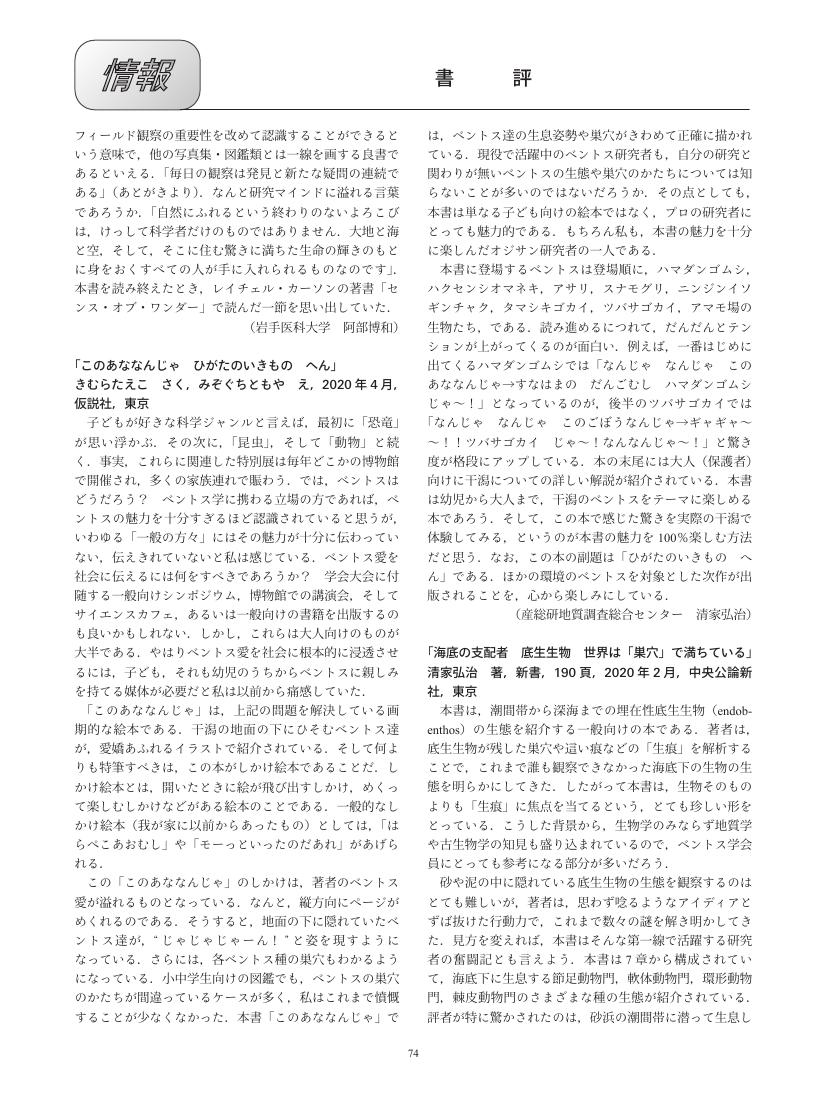7 0 0 0 OA 書評「このあななんじゃ ひがたのいきもの へん」
- 著者
- 清家 弘治
- 出版者
- 日本ベントス学会
- 雑誌
- 日本ベントス学会誌 (ISSN:1345112X)
- 巻号頁・発行日
- vol.75, pp.74, 2020-12-25 (Released:2020-12-24)
- 著者
- 奈良 正和 清家 弘治
- 出版者
- 日本地質学会
- 雑誌
- 地質學雜誌 (ISSN:00167630)
- 巻号頁・発行日
- vol.110, no.9, pp.545-551, 2004-09-15
- 参考文献数
- 37
- 被引用文献数
- 3 26
千葉県九十九里浜の前浜堆積物中から,多数のMacaronichnus segregatis様生痕を発見した.この生痕は,剥ぎ取り試料面上において高さ2-3mm,幅3-50mmほどの円形もしくは長楕円形を成し,内部が細粒砂サイズの無色鉱物で充填され,その周囲に磁鉄鉱などの有色鉱物が濃集することが特徴である.この生痕ときわめて似た特徴を有する本邦第四系産生痕化石Macaronichnus segregatisの形成者については,従来,小型等脚類ヒメスナホリムシとするものと,オフェリアゴカイの様なゼン虫類とするものの2つの説があった.この生痕が産する堆積物からは,ヒメスナホリムシは一切採集されなかったものの,オフエリアゴカイ科の多毛類であるEuzonus sp.が多数採集された.このことから判断すると,このM.segregatis様生痕の形成者は,オフェリアゴカイ類と判断して良いだろう.
2 0 0 0 OA 日本最長寿の二枚貝殻に刻まれた津波と大気圏核実験の履歴
- 著者
- 窪田 薫 白井 厚太朗 杉原 奈央子 清家 弘治 棚部 一成 南 雅代 中村 俊夫 Kubota Kaoru Shirai Kotaro Sugihara-Murakami Naoko Seike Koji Tanabe Kazushige Minami Masayo Nakamura Toshio
- 出版者
- 名古屋大学宇宙地球環境研究所
- 雑誌
- 名古屋大学年代測定研究
- 巻号頁・発行日
- vol.2, pp.1-6, 2018-03-31
Mercenaria stimpsoni (Stimpson's hard clam), found in shallow sandy seafloor of northeast Japan, has been proved to have longevity of more than 100 years, which is the longest record in Japan. The present study established nuclear bomb testing induced bomb-14C records from M. stimpsoni shells, for the first time in high latitude western North Pacific, in which chronology is robustly constrained from a synchronized annual growth width pattern among individuals. The record revealed a strong influence of Tsugaru Warm Current on shallow water of northeast Japan. Furthermore, age-determination of dead shells collected from the seafloor of the study region by utilizing the established bomb-14C records suggests that past tsunamis are one of the most important reasons of death of M. stimpsoni.東北日本(岩手県大槌)から見つかった二枚貝の一種ビノスガイ(Mercenaria stimpsoni)は100歳を超す寿命を持ち,日本産の二枚貝としては最長寿であることが最近明らかになった.本研究では,ビノスガイの殻を用いて,複数個体間で同期した年間成長パターンをもとに厳密な年代モデルを構築し,東北地域としては初となる核実験起源の放射性炭素曲線を復元した.その結果,三陸沖の浅海域においては,津軽暖流(対馬海流を起源とする)の影響が強く見られることがわかった.さらに,得られた放射性炭素曲線を大槌の海底から得られた死殻の死亡年代の推定に用いることで,過去の津波イベントがビノスガイの死を招く重要な要因になっている可能性が示された.
1 0 0 0 OA 白鳳丸世界一周KH-19-6航海での南半球ベントス採集記
1 0 0 0 OA アナジャコウロコムシ(環形動物門ウロコムシ科)の東日本からの記録
- 著者
- 佐藤 正典 加藤 哲哉 清家 弘治 伊谷 行
- 出版者
- 日本動物分類学会
- 雑誌
- タクサ:日本動物分類学会誌 (ISSN:13422367)
- 巻号頁・発行日
- vol.41, pp.30-39, 2016-08-30 (Released:2017-02-07)
- 参考文献数
- 25
The scale worm Hesperonoe hwanghaiensis Uschakov and Wu, 1959 (Annelida: Polynoidae) is recorded from eastern Japan, based on four specimens collected from Akkeshi Bay, Hokkaido, and Kashima-nada, Ibaraki Prefecture. In Akkeshi Bay, three specimens (body length of a complete specimen: 40 mm, body width without parapodia: 4.0–4.5 mm), which are the largest of all Japanese specimens including previous records, were found from mud and sand sediments at intertidal flats, where a mud shrimp Upogebia major (De Haan, 1841) was collected simultaneously. In Kashima-nada, a complete mature male specimen (body length: 23 mm, body width without parapodia: 2.7 mm) was collected by dredging at subtidal sandy bottom at a water depth of 7.6 m, where another mud shrimp Austinogebia narutensis (Sakai, 1986) was collected simultaneously. The morphological characteristics of these specimens basically agreed with those of the previous records on the specimens collected from western Japan, with a diagnostic characteristic of the presence of a row of the more conical macrotubercles (up to 28 in an elytron of the complete specimen from Akkeshi Bay, and up to 3 in that from Kashima-nada) on the posterior surface of the elytra in the larger specimen. The present result suggests that the scale worm is commensal with not only U. major but also A. narutensis in its habitats extending from intertidal flats in semi-enclosed inner bays to subtidal bottom in open coasts.


